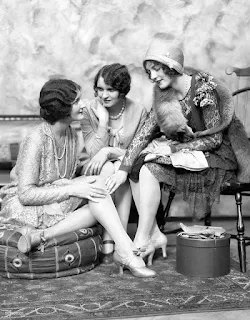Evolution of Fashionable Clothes for Women
A Journey Through Time and Trends
**Ancient Elegance: The Birth of Fashion:**
The origins of fashionable clothing for women can be traced back to ancient civilizations, where attire served not only as a means of protection but also as a symbol of status and identity. In Mesopotamia, intricate garments adorned with embellishments denoted social hierarchy, while in ancient Egypt, linen robes symbolized purity and elegance, epitomized by the iconic drapery of the Egyptian queen, Cleopatra.
During the medieval period, European fashion underwent significant transformations, with women's attire evolving from voluminous robes to more tailored silhouettes. The Renaissance era heralded a revival of classical aesthetics, as sumptuous fabrics, intricate embroidery, and corseted bodices became emblematic of aristocratic femininity, exemplified by the opulent gowns depicted in paintings by renowned artists like Leonardo da Vinci and Raphael.
**Victorian Virtue: Modesty and Mastery of Fashion:**
The Victorian era ushered in a paradigm shift in women's fashion, characterized by the prim and proper aesthetic synonymous with Queen Victoria's reign. High-necked gowns, voluminous skirts, and tight-fitting bodices exuded an aura of modesty and refinement, reflecting the prevailing Victorian values of morality and decorum. The emergence of the sewing machine facilitated mass production, democratizing fashion and paving the way for ready-to-wear garments.
The 1920s witnessed a seismic shift in women's fashion, epitomized by the revolutionary flapper style that challenged traditional notions of femininity. Shorter hemlines, dropped waists, and boyish silhouettes symbolized newfound freedom and liberation, as women embraced a more daring and independent approach to dressing. The iconic designs of Coco Chanel and the glamorous allure of Hollywood starlets like Louise Brooks encapsulated the spirit of the Jazz Age, redefining the sartorial landscape of the era.
**Mid-Century Marvels: Glamour, Grace, and the Golden Age of Couture:**
The mid-20th century witnessed the emergence of haute couture houses and the democratization of fashion through the advent of ready-to-wear collections. The post-war period saw a resurgence of femininity, as Christian Dior's New Look silhouette revolutionized women's fashion with its emphasis on nipped-in waists and voluminous skirts. Hollywood icons such as Audrey Hepburn and Grace Kelly became style icons, influencing fashion trends with their timeless elegance and sophistication.
**Swinging Sixties: Youth quake and the Rise of Youth Culture:**
The 1960s heralded a cultural revolution that reverberated through the world of fashion, as the youth-driven counterculture challenged mainstream norms and conventions. The miniskirt, popularized by British designer Mary Quant, became a symbol of youthful rebellion and liberation, while psychedelic prints and bold colors reflected the spirit of the swinging sixties. Icons like Twiggy and Brigitte Bardot epitomized the era's mod aesthetic, inspiring a generation to embrace individuality and self-expression through clothing.
**Disco Fever: Glitter, Glamour, and Studio 54 Chic:**
The disco era of the 1970s was characterized by excess, hedonism, and a penchant for opulent glamour. Sequined jumpsuits, slinky wrap dresses, and platform shoes defined the sartorial sensibilities of the era, as women embraced a flamboyant and flamboyant approach to dressing. Studio 54 became the epicenter of nightlife and fashion, where celebrities and socialites mingled amidst a backdrop of pulsating beats and dazzling attire, epitomizing the hedonistic spirit of the disco era.
**Power Dressing: The Eighties and the Rise of Career Chic:**
The 1980s witnessed the ascendance of power dressing, as women sought to assert their authority and ambition in the male-dominated corporate world. Sharp-shouldered blazers, tailored suits, and bold accessories became sartorial symbols of female empowerment and ambition, as exemplified by the iconic style of powerhouses like Margaret Thatcher and Madonna. The era's penchant for excess was reflected in exaggerated silhouettes and ostentatious embellishments, epitomizing the brash confidence of the decade.
**Minimalism and Grunge: Nineties Nostalgia and Anti-Fashion Sentiments:**
The 1990s marked a departure from the excesses of the previous decade, as a wave of minimalism and grunge aesthetics swept through the fashion world. The rise of designers like Calvin Klein and Helmut Lang heralded a return to understated elegance and simplicity, with clean lines and neutral palettes dominating the runway. Meanwhile, the grunge movement embraced a more rebellious and anti-establishment ethos, as flannel shirts, ripped jeans, and combat boots became emblematic of youthful angst and disillusionment.
**Contemporary Chic: Diversity, Sustainability, and Digital Disruption:**
In the 21st century, fashion has become increasingly diverse, inclusive, and socially conscious, reflecting the evolving values and aspirations of modern women. The rise of sustainable fashion movements has led to a greater emphasis on ethical production practices and environmental stewardship, as consumers demand transparency and accountability from brands. Digital technologies and social media have democratized fashion, empowering individuals to express their personal style and influence trends in real-time.
**Conclusion:**
The evolution of fashionable clothing for women is a testament to the transformative power of style, as it reflects the cultural zeitgeist and societal shifts of each era. From ancient civilizations to the contemporary era, women's fashion has continuously evolved, transcending boundaries and redefining norms. As we continue to navigate the ever-changing landscape of fashion, let us celebrate the diversity, creativity, and resilience that define the timeless allure of fashionable clothing for women.











